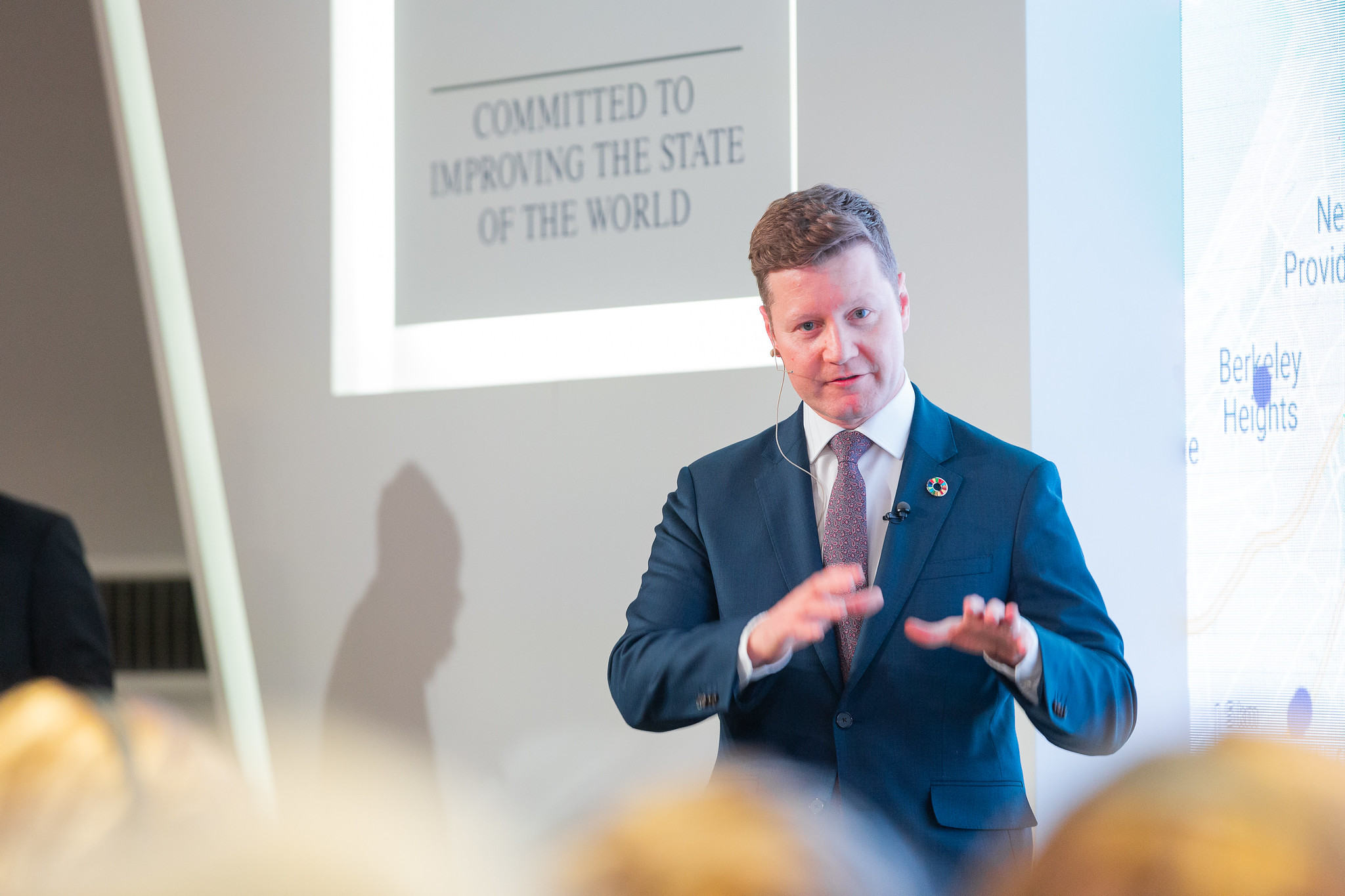Few people have watched the sustainability reporting and climate risk worlds evolve more closely than Dr Richard Mattison. Back in 2004 as CEO of Trucost, his team ran the first analysis of the carbon emissions of an investment portfolio. As he recalls, speaking to ESG Insight: “Back in those days even the basic principle was a challenge – like ‘can you really expect the finance sector to be taking any responsibility for emissions at all?’ So since those days, we have certainly come a long way…”
With firms managing $130 trillion now committed to net-zero, what seemed a leftfield project back in 2004 is now primetime material. Trucost meanwhile was bought by S&P Global in 2016 and Mattison is now president of S&P Global Sustainable1, the market intelligence heavyweight’s “single source of essential sustainability intelligence” which launched in April 2021 – and which is home to a colossal 700 billion ESG data points.
Yet for all the progress in driving both climate risk and emissions reporting firmly into the limelight, there’s a hell of a lot of work to do, he notes: “As an industry we still struggle to measure emissions of a portfolio” he emphasizes. “It’s crazy that actually we haven’t gone as far as we could on that front, in terms of common standards and well reported information that is meaningful for investment decision making.”
Driving home that point he notes: “Last year as a company, we corrected over 2,500 climate disclosures by companies, simply because they’re not standardised; they’re not made comparable; not reported in alignment with the Greenhouse Gas Protocol.”
Sustainability reporting standardization? There’s a long way to go still…
Those corrections encapsulate some of the issues with what is a still – despite the sheer surge in industry noise around ESG reporting – a deeply immature market.
As Mattison notes, with financial accounting standards, although there is some room for variation, they ultimately prescribe clearly what you need to report from a financial perspective: “If there is variation, you have to report what the variation is and why. So when it comes to something like EBITDA), you know that you can compare that number with someone else’s number. In climate, you really can’t. Even on emissions there’s significant scope for variability. So we find that some companies will report on headquartered country operations, but not operations in China, for example. And we find that companies pick and choose the aggregation methods for accounting on emissions. So they might choose to only report on the emissions associated with sites they control, rather than on an equity basis. And they give you different numbers…
“Let’s say you own 30% of a mine. If your financial accounts use the ownership method of accounting, but you’re using the control method of accounting for your emissions reporting, they’re not comparable. So you can’t compare profit with emissions, because you’re using different ways of aggregating profit versus aggregating emissions. All we ask for is consistency” he says, laughing drily at the fact it remains such a huge task.
> Follow ESG Insight on LinkedIn
Right into the significantly more complex realm of Scope 3 emissions, Sustainable1 is “trying to build a way that is consistent for S&P Global, so that when we report on 15,000 companies, we can tell you that we’re providing consistency and comparability” he emphasizes. “That’s what we put a lot of effort behind. That’s also important for us because when we’re constructing investment benchmarks, like the S&P 500 ESG index, or when we’re integrating this information in the context of credit ratings, we need to make sure that we are doing this consistently, otherwise we’d be replicating the variability of what is in the marketplace today, which would be a disaster.”
Coming out of COP26 and while excited at the “incredible progress” seen in recent years, Mattison sounds a cautionary note: “We have to go further in ensuring that we are measuring and reporting on the right information. If we don’t do that, then we could be standing on the brink of the largest greenwashing exercise history’s ever seen. I’m incredibly optimistic. But we need to put some rigour into the marketplace right now.”
“This topic has risen to the top of the board agenda”
Just how seriously are both the investment and corporate communities taking sustainability reporting, really, we ask? The current “lack of rigour” does allow leaders to exploit some of the loopholes alluded to above – pushing polluting/environmentally destructive companies to the opaque fringes of their supply chain and playing games with reporting standards that showcase their performance in the best of possible lights.
S&P Global Sustainable1 President Dr Richard Mattison believes that the impetus is firmly with companies and leaders who do take their sustainability commitments seriously – ultimately that most efforts come with the genuine intent to reduce environmental impact, for example. There are several drivers of that shift. He points to the latest United Nations Global Compact – Accenture CEO Study on Sustainability, which surveyed 1,230 CEOs across 113 countries and 21 industries as one example.
The report showed that nearly half of CEOs globally (49%) are grappling with supply-chain interruptions due to extreme weather events and climate risk has become a priority. (As Thomas Buberl, CEO of AXA Group, noted in the report: “Large events like Katrina still occur in a relatively uniform frequency, but what we’ve seen is that smaller events such as wildfires and rainstorms have massively increased in frequency. This has become a reality, and everybody can feel climate change in their daily lives.”)
Arguably more importantly, it noted that companies that are regarded as sustainability leaders also outperform their industry peers on traditional business metrics. As Mattison puts it: “This is a topic that’s kind of risen right to the top of the board agenda.”
He adds: “If you look at the companies that have signed up to net zero commitments, they haven’t done so lightly. They’ve done so with an understanding that to get to a meaningful, large scale emissions reduction, you need to double the amount of renewables we’re using by 2025 from 2019 levels for example, or halve emissions by 2030 for your company. If you went back about three years ago, I think the narrative was, ‘do we want to go through that transition? Why would we want to do that? It’s going to cost us more money and present challenges to business models…”
“But I think increasingly people are recognising that there’s no escaping the transition – because the alternative is facing a far greater amount of global disruption associated with the physical impacts of climate change. A billion children are at risk of climate change; we will see mass migration; we’ll see major shifts in geopolitics. We’ll see huge swathes of the world uninhabitable, massive economic losses, far greater than the pandemic we’ve just gone through, without real action. The economic and financial consequences of climate change far outweigh any uncertainty, volatility or financial consequences of transition by most estimates. Companies are going to be forced down that route if they do not act and I think they’ve woken up to that fact.”
In the investment community, that’s also going to require much more robust approaches to how they label funds and the datasets they are using to inform investment decisions. (We’ve already seen the UK’s Financial Conduct Authority for example warn sternly that “we receive a high volume of applications for authorisation of funds with a sustainable focus… many are poor-quality and fall below our expectations.”) And as Mattison puts it: “Can you expect an ESG fund to drive meaningful climate impact? Perhaps not; perhaps you need to invest in a Climate Fund. Or perhaps you should, but then not only say ‘my fund’s an ESG fund, but it also has the following characteristics on climate, on diversity on whatever and by the way, we’ve overweighted the importance of climate to make sure that is coming through…’”
Getting serious about comparable, machine-readable data
As the IMF noted in a recent report: “To give investors access to decision-useful information to effectively price and manage climate risks, there is an urgent need to strengthen the climate information architecture”. The IMF added that it saw “three building blocks needed to support this broader shift.
“i) high-quality, reliable, and comparable data
ii) a harmonized and consistent set of climate disclosure standards, and
(iii) a broadly agreed upon global taxonomy.
Ticking every one of those three boxes will take some joined up thinking – and the wide use of reporting technologies like XBRL. As Mattison puts it: “If you produce a sustainability report, you put it on your website… there’s no standard place to put it.
“It’s not like it always sits in a filing or annual report. It might do in the future, but now, that’s just not the case; you have to go looking for it. Then all the terms and definitions might vary a lot: whether something’s a data point, or a narrative varies from company to company; that makes it really hard to pull that information in to analyse.”
“What will result in significant democratisation of this type of information is if the information is electronically tagged, and referenced to one or more standards — so anybody looking for that information could use a machine to gather the data in a far more automated way and refer it to a particular standard. Ideally, that should include multiple referencing to help understand equivalency. So the EU asks you to report this way, but you also might need to report to the investment industry this way; the SEC in the US this way. Having some kind of meta tagging of the information allows you to say, ‘this is carbon emissions; this sits in the EU framework this way, it sits in the US framework this way, it sits in the International Sustainability standards board KPI number 16’ etc. this way. And when it comes to common good, that’s arguably the single thing that will help most with information flow. At the moment it’s really hard to understand sustainability information: you have to be trained to interpret it. And even if you are trained, you often don’t know what you’re looking at.” (Europe is pushing for XBRL use for CSRD, which applies to 50,000 companies — but only in the context of their own reporting standard. The SEC mandated XBRL use for financial filings in 2021, but its broader adoption for sustainability reporting remains in its infancy…)
For all the still-substantial challenges around transparency, supply chain reporting and standards, money talks and is going to talk increasingly loudly. A little-noticed chart in the Accenture-UN CEO report revealed that consumers are still by far the most substantial driver of sustainability-related changes at the corporate level and, as Mattison notes, “we sit in the middle of the largest intergenerational transfer of wealth: $68 billion dollars shifting to millennials in the US alone – and when you survey those millennials on their investment preferences, the majority of them say ‘yeah, I want return, but I also want impact, I don’t want to be retiring in a world that’s a disaster.’
“We are going to see some significantly different pressures on the market as we see that transfer of wealth. These appetites and these needs need to be catered for. That’s the reason why 50% of inflows to ETFs in Europe are linked in some way to ESG funds. I see a future in which people can dial up and down the sustainability impact of their portfolio on their investment applications at a quite granular level – we are going to see some really big changes in the financial landscape and in the impact landscape.”
What are your views on the integrity of ESG reporting? Get in touch.









